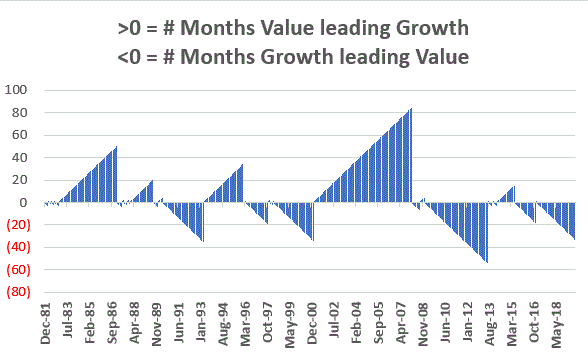In Part I here, I basically made the argument that nothing ever stays the same forever in the stock market, but that things do often repeat (or more accurately, alternate). In Part I, I highlighted the “back and forth” nature of the historical performance between U.S. stock indexes and international stock indexes, and that the fact that U.S. stocks have vastly outperformed international stocks in recent years is likely NOT a permanent trend (although it could go on for some time).
In a similar vein, we can also look at growth stocks versus value stocks.
Growth versus Value
In recent years it has not been uncommon to hear the refrain that “Value investing is dead.” As I pointed out previously in this article, that sentiment is likely completely unfounded. Analysis of growth versus value comes down to what time period you want to focus on. In Figure 1 we see that since July 2007, the Russell 1000 Growth Index has gained +295% versus only +140% for the Russell 1000 Value Index.

Figure 1 – Growth of $1,000 invested in Russell 1000 Growth Index (blue) versus Russell 1000 Value Index (orange); Jul-2007 through Sep-2019
So, it is understandable to a point that some investors would conclude that growth investing is superior to value investing. However, if we look at the full period from December 1978 through September 2019, we find that Value gained +9,601% versus +8,074% for Growth.

Figure 2 – Growth of $1,000 invested in Russell 1000 Growth Index (blue) versus Russell 1000 Value Index (orange); Dec-1978 through Sep-2019
But the real story is the “back and forth” nature of the performance of these two asset classes. Figure 3 displays:
*3-year return for Russell 1000 Value Index minus 3-year return for Russell 1000 Growth Index
*Positive readings indicate that Value has outperformed Growth over prior 3 years
*Negative readings indicate that Growth has outperformed Value over prior 3 years

Figure 3 – Cumulative 3-year total return for Russell 1000 Value Index minus cumulative 3-year total return for Russell 1000 Growth Index; Dec-1981-Sep-2019
Figure 4 displays the length of time (in months) during which Value has outperformed Growth (positive values) and the length of time (in months) during which Growth has outperformed Value (negative values)
Here is how to read Figure 4:
*If Value has outperformed Growth over the previous 3 years, then the value is positive and gets more positive with each month that Value leads Growth.
*If Value has underperformed Growth over the previous 3 years, then the value is negative and gets more negative with each month that Value trails Growth.

Figure 4 – # of Months Value outperformed Growth (positive) and vice versa (negative); Dec-1981-Sep-2019
The primary point is to note an obvious “ying” and “yang” over time, i.e., growth stocks lead for a period of time, then value stocks lead for a period of time.
Given the advantage that growth stocks have enjoyed over the previous 12 years, I can’t help but think that value stocks will once again gain favor sometime in the not too distant future.
One ETF for consideration in this realm is ticker VLUE (iShares Edge MSCI USA Value Factor ETF). Remember, I am not “recommending” that anyone rush out and buy this ETF. I am merely raising the prospect – based on the historical give and take between growth and value – that value may look a lot better in the years ahead than in the years just passed.
Jay Kaeppel
Disclaimer: The information, opinions and ideas expressed herein are for informational and educational purposes only and are based on research conducted and presented solely by the author. The information presented does not represent the views of the author only and does not constitute a complete description of any investment service. In addition, nothing presented herein should be construed as investment advice, as an advertisement or offering of investment advisory services, or as an offer to sell or a solicitation to buy any security. The data presented herein were obtained from various third-party sources. While the data is believed to be reliable, no representation is made as to, and no responsibility, warranty or liability is accepted for the accuracy or completeness of such information. International investments are subject to additional risks such as currency fluctuations, political instability and the potential for illiquid markets. Past performance is no guarantee of future results. There is risk of loss in all trading. Back tested performance does not represent actual performance and should not be interpreted as an indication of such performance. Also, back tested performance results have certain inherent limitations and differs from actual performance because it is achieved with the benefit of hindsight.

